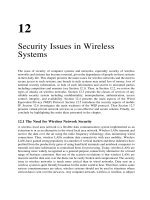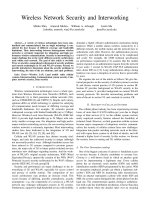Programming Wireless Security
Bạn đang xem bản rút gọn của tài liệu. Xem và tải ngay bản đầy đủ của tài liệu tại đây (761.03 KB, 52 trang )
Interested in learning
more about security?
SANS Institute
InfoSec Reading Room
This paper is from the SANS Institute Reading Room site. Reposting is not permitted without express written permission.
Programming Wireless Security
This paper is an introduction to some of the programming
techniques needed to build wireless security tools. It will go
through installing some basic tools then discuss topics including
packet injection, sniffing and filtering and give a brief overview of
WPA Pre­Shared Key and the EAPO
Copyright SANS Institute
Author Retains Full Rights
AD
© SANS Institute 2008, Author retains full rights.
© SANS Institute 200 8, Author retains full rights.
Key fingerprint = AF19 FA27 2F94 998D FDB5 DE3D F8B5 06E4 A169 4E46
Programming Wireless Security
Programming Wireless Security
GAWN Gold Certification
Author: Robin Wood,
Adviser:Joey Neim
Accepted: November 12th 2007
Robin Wood 1
© SANS Institute 2008, Author retains full rights.
© SANS Institute 200 8, Author retains full rights.
Key fingerprint = AF19 FA27 2F94 998D FDB5 DE3D F8B5 06E4 A169 4E46
Programming Wireless Security
Table of Contents
1 Introduction 5
2 Setting Up The Lab 6
1.Development/Attacker Machine 6
2.Network Sniffer 6
3.Victim 6
4.Access Point 6
3 The Tools 7
4 “Hello World” 10
1.Python 10
2.Ruby 11
3.Running the Scripts 11
5 802.11 Frame Structure 12
1.802.11 Frame Overview 13
1.Frame Header 13
2.The Frame Control Field 14
2.Beacon Frames 17
Robin Wood 2
© SANS Institute 2008, Author retains full rights.
© SANS Institute 200 8, Author retains full rights.
Key fingerprint = AF19 FA27 2F94 998D FDB5 DE3D F8B5 06E4 A169 4E46
Programming Wireless Security
3.Deauthentication Frames 18
4.802.11i Authentication Packets and the WPA Handshake 20
6 A Useful “Hello World” 24
1.Python 25
2.Ruby 26
3.Comments on the Scripts 27
4.Running the Scripts 28
7 Deauthentication Attack 28
1.Python 28
2.Ruby 29
8 Sniffing Wireless Traffic 31
1.Python 32
2.Ruby 33
3.Comments on the Scripts 33
4.Running the Scripts 34
9 Automating a Four-Way-Handshake Capture 34
1.Python 36
Robin Wood 3
© SANS Institute 2008, Author retains full rights.
© SANS Institute 200 8, Author retains full rights.
Key fingerprint = AF19 FA27 2F94 998D FDB5 DE3D F8B5 06E4 A169 4E46
Programming Wireless Security
2.Ruby 38
3.Comments on the Scripts 42
4.Running the Scripts 43
5.What to do with the collected handshake 43
10 Summary 43
11 References 45
Appendix A 46
1.Scapy Issues 46
2.Scruby Issues 46
Appendix B 48
1.Deauthentication Reason Codes 48
Robin Wood 4
© SANS Institute 2008, Author retains full rights.
© SANS Institute 200 8, Author retains full rights.
Key fingerprint = AF19 FA27 2F94 998D FDB5 DE3D F8B5 06E4 A169 4E46
Programming Wireless Security
1 Introduction
This paper is an introduction to some of the programming
techniques needed to build wireless security tools. It will go
through installing some basic tools then discuss topics including
packet injection, sniffing and filtering and give a brief overview of
WPA Pre-Shared Key and the EAPOL 4 way handshake. All the techniques
will be brought together to create an application to automate
capturing an EAPOL handshake which can then be used to attempt to
crack the Pre-Shared Key.
Due to the current popularity of both Ruby and Python all the
code samples used will be given in both languages. The tools used and
created are intended to be used on a Linux system but the concepts
discussed are generic. The paper will be distribution independent
with required applications being installed from source rather than
using packages, however, if you are able to install the required
packages through your distribution it may be easier. If you do this
you need to check version numbers and you may need to modify paths or
other information.
This paper is not designed to teach programming and assumes at
least a basic knowledge of programming and wireless terminology.
All WPA PSK discussions apply equally to both WPA or WPA2 as
they both use the same authentication techniques.
Robin Wood 5
© SANS Institute 2008, Author retains full rights.
© SANS Institute 200 8, Author retains full rights.
Key fingerprint = AF19 FA27 2F94 998D FDB5 DE3D F8B5 06E4 A169 4E46
Programming Wireless Security
2 Setting Up The Lab
To make building and testing your applications easier you will
require the following:
1. Development/Attacker Machine
This is the main development machine. It will need Linux and all
the tools described in the next section installed. It will need a
wireless card which supports monitor mode and packet injection. All
work done in this paper is based on an Atheros based wireless card
running the madwifi-ng version 0.9.4.
2. Network Sniffer
While not essential this is a useful tool to the check packets
you are injecting are being transmitted correctly and to confirm that
any packet sniffing your application is doing matches a tried and
tested application. Kismet [5] is an ideal choice here.
3. Victim
This is any machine which can connect to a WPA network. When in
need of a spare machine I found my mobile phone which supports wifi
worked well enough.
4. Access Point
A standard access point configured with WPA PSK.
Ideally all these are separate devices however it is sometimes
impractical to have 4 machines so the network sniffer and victim can
be the same machine, switching between the two functions as
Robin Wood 6
© SANS Institute 2008, Author retains full rights.
© SANS Institute 200 8, Author retains full rights.
Key fingerprint = AF19 FA27 2F94 998D FDB5 DE3D F8B5 06E4 A169 4E46
Programming Wireless Security
necessary. It is also possible to have multiple wireless devices on
the same machine.
3 The Tools
In this section we will go through installing the tools required
for the rest of the paper.
● Lorcon
Lorcon is a tool created by Josh Wright and Mike Kershaw
(Dragorn) to simplify packet injection on 802.11 networks. It
supports a large number of wireless cards, a list of which can be
found on its homepage .
To install it, download the latest version from:
svn co />Then run the standard Linux
./configure
make
make install
Next, as root, edit the file /etc/ld.so.conf and check there is
a line for /usr/local/lib. If there is not then add it then run
ldconfig
To check the install worked run
ldconfig -v|grep liborcon
If you see a line like this:
liborcon-1.0.0.so -> liborcon.so
then the install worked, if not check ld.so.conf again.
Robin Wood 7
© SANS Institute 2008, Author retains full rights.
© SANS Institute 200 8, Author retains full rights.
Key fingerprint = AF19 FA27 2F94 998D FDB5 DE3D F8B5 06E4 A169 4E46
Programming Wireless Security
To test Lorcon is properly installed it comes with a test
application. To make it run from within the source directory
make tx
This will build the tx binary which can be ran by
./tx
This will give you some help text and a list of supported
drivers. To actually transmit some packets you can run it like this:
./tx -i ath0 -n 200 -c 10 -s 10 -d madwifing
Assuming everything is installed correctly you should get some
timing information. If you get any errors but you got the help text
from running the binary on its own then Lorcon is at least partially
working. In this situation, to get support I suggest joining the
Lorcon mailing list [4].
● Pylorcon
Pylorcon is a python wrapper for Lorcon. The latest version can
be downloaded from:
/>Watch out when unpacking the tarball as, at time of writing, it
didn't contain a directory structure and so unpacked the files into
the current directory.
Install instructions can be found in the README file.
The package comes with a tx.py test script which emulates the tx
program from Lorcon.
● Scapy
Scapy describes itself as “a powerful interactive packet
Robin Wood 8
© SANS Institute 2008, Author retains full rights.
© SANS Institute 200 8, Author retains full rights.
Key fingerprint = AF19 FA27 2F94 998D FDB5 DE3D F8B5 06E4 A169 4E46
Programming Wireless Security
manipulation program” [6]. It can be used to both send and receive
data at layer 2 and 3 and can dissect a large number of different
protocols. Added to this is the built in ability to perform other
tasks such as ARP cache poisoning and port scanning.
In this paper I will be covering using Scapy to perform packet
filtering and dissection but I encourage readers to learn more about
the other aspects of this very flexible tool.
Scapy can be downloaded from:
/>The scapy.py file needs to be included in the same directory as
your python script to use it.
At the time of writing, the current version of Scapy (version
1.1.1) is missing a feature needed towards the end of this paper see
Appendix A for further details.
● ruby lorcon
This is a Ruby wrapper for Lorcon and is distributed with the
Metasploit framework, however Metasploit does not need to be
installed for the wrapper to work. To install it, download the latest
Metasploit from The wrapper can be found
in the /external/ruby-lorcon directory. It comes with a readme file
on how to install it.
The wrapper also comes with a test script, test.rb which
emulates the tx program from Lorcon.
● Scruby
Scruby is a Ruby port of Scapy. It currently contains a much
smaller subset of protocols but is being actively developed with
Robin Wood 9
© SANS Institute 2008, Author retains full rights.
© SANS Institute 200 8, Author retains full rights.
Key fingerprint = AF19 FA27 2F94 998D FDB5 DE3D F8B5 06E4 A169 4E46
Programming Wireless Security
protocols being ported from Scapy all the time. As with the Ruby
Lorcon wrapper, it is distributed with Metasploit and can be found in
the lib/scruby directory.
Also, as with Scapy, there are a number of issues which are
documented in Appendix A.
4 “Hello World”
The first application we will build is the standard “hello
world”.
1.
Python
#!/usr/bin/env python
import sys
import pylorcon
lorcon = pylorcon.Lorcon("ath0", "madwifing")
lorcon.setfunctionalmode("INJECT");
lorcon .setmode("MONITOR");
lorcon.setchannel(11);
print "About to transmit Hello World";
packet = 'Hello World';
for n in range(1000):
lorcon.txpacket (packet);
print "Done";
The script starts by importing the system and the Lorcon
packages and then creates a new instance of the Lorcon class. The two
parameters are the wireless interface and the driver. The full list
of drivers can be found on the Lorcon homepage [4] but be aware, not
all drivers support all features.
The next functions setup the card into the correct mode and set
Robin Wood 10
© SANS Institute 2008, Author retains full rights.
© SANS Institute 200 8, Author retains full rights.
Key fingerprint = AF19 FA27 2F94 998D FDB5 DE3D F8B5 06E4 A169 4E46
Programming Wireless Security
the channel. A packet is created with the contents “Hello World” and
is then transmitted 1000 times by the txpacket command in the for
loop. The large number of transmissions makes it easier to spot the
packet in a packet capture.
2.
Ruby
#!/usr/bin/env ruby
require "Lorcon"
wifi = Lorcon::Device.new('ath0', 'madwifing')
wifi.fmode = "INJECT"
wifi.channel= 11
wifi.txrate = 2
wifi.modulation = "DSSS"
packet = "Hello World";
1000.times do
wifi.write(packet)
end
puts "Done"
The Ruby script works in a similar way to the Python one, it
initially imports the Lorcon library then sets up up the card and
defines the driver and the interface. The packet is then created and
transmitted 1000 times.
3.
Running the Scripts
Before running the scripts, start up a wireless packet sniffer
on your monitor box and lock it to your chosen channel. You are now
ready to run your script. Once it has finished close down the
sniffer and view the packet capture file created. I recommend using
Wireshark ( as it allows you to easily
manipulate and dissect packets.
Robin Wood 11
© SANS Institute 2008, Author retains full rights.
© SANS Institute 200 8, Author retains full rights.
Key fingerprint = AF19 FA27 2F94 998D FDB5 DE3D F8B5 06E4 A169 4E46
Programming Wireless Security
When viewing this packet capture, a packet dissector will
probably claim that all the packets are malformed, however if you
look at the actual data captured you should see the packet contains
the string “hello world”. This is because the data we told to the
scripts to send was not a valid 802.11 packet just a piece of text.
This highlights an important point, Lorcon will send any data it is
told do and does not do any validity checking. This can be both a
good and a bad thing depending on what you are trying to achieve. The
good side is that it allows you to create packets with any content
and so it is easy to create fuzzers and other tools which need to
send out non-standard data. The bad side is that if you make a
mistake when crafting your packet there is nothing to pick it up.
This is why I highly recommend using something like Wireshark to
monitor all the data you are sending as its protocol analyser allows
you to check each individual field in the packet which makes
troubleshooting a lot easier.
5 802.11 Frame Structure
This chapter will give an overview of the 802.11 frame
structure, highlighting areas which will be of importance in the
upcoming chapters.
For this paper we will be interested in 3 specific types of
message:
● Beacon Frame – The message sent out from an access point to
advertise its presence.
● Deauthentication Frame – This message can be sent by either an
access point or a station (client machine) and is used to
indicate that the authentication between the two is finished.
Robin Wood 12
© SANS Institute 2008, Author retains full rights.
© SANS Institute 200 8, Author retains full rights.
Key fingerprint = AF19 FA27 2F94 998D FDB5 DE3D F8B5 06E4 A169 4E46
Programming Wireless Security
When sent by an access point, the message can either be targeted
at a single client or it can be broadcast to deauthenticate all
associated clients.
● The 802.11i handshake – This will be discussed in more detail
later but is the way WPA Pre Shared Key handles authentication.
If you are interested in further information about the 802.11
specification, a good technical reference for the whole standard can
be found on the IEEE website [3].
1.
802.11 Frame Overview
The 802.11 specification defines three types of frames:
● Management – frames used to manage the network, including
beacons, probes and authentication.
● Data – The actual data being carried by the network, can be
encrypted (WEP or WPA) or unencrypted.
● Control – These frames are used acknowledge the receipt of data
packets.
All data transmitted on the network should be one of these
types. The data will be wrapped in a structure called the frame
header which will be discussed in the next section. It is the lack of
this frame header which would cause dissectors to report that the
“Hello World” example is corrupt data.
1. Frame Header
Each frame contains a standard header as shown in Figure 1.
Robin Wood 13
© SANS Institute 2008, Author retains full rights.
© SANS Institute 200 8, Author retains full rights.
Key fingerprint = AF19 FA27 2F94 998D FDB5 DE3D F8B5 06E4 A169 4E46
Programming Wireless Security
The header contains all the information needed to get the frame
to where it is going and allow the receiver to understand what
message the frame is carrying.
The first field is the Frame Control (FC) field, this is a
bitmap which contains options which specify the layout of the rest of
the frame. This field will be discussed in more detail in the next
section.
Next comes the address fields, the first three fields are
mandatory while the fourth is optional and is only used in a Wireless
Distribution System (WDS). When not used, this space contains data.
The meaning of the address fields varies depending on type of the
frame as explained below.
The sequence control (SEQ) field is used for fragmentation and
packet reassembly.
After the header comes the data field which can be of variable
length, and finally comes the Frame Check Sequence (FCS). This is a
CRC value covering both the header and the body.
2. The Frame Control Field
The frame control field is a bitmap field which specifies how
the rest of the header is laid out. Its structure is shown in Figure
2.
Robin Wood 14
Figure 1: 802.11 Frame Header
© SANS Institute 2008, Author retains full rights.
© SANS Institute 200 8, Author retains full rights.
Key fingerprint = AF19 FA27 2F94 998D FDB5 DE3D F8B5 06E4 A169 4E46
Programming Wireless Security
The first field, protocol, is currently always set to 0.
The “Type” and “Subtype” values are used to specify the type of
packet. “Type” can be one of four values:
● 00 – Management
● 01 – Control
● 10 – Data
● 11 – Reserved/Unused
The “Subtype” then breaks the type down further, some common
examples are (type/subtype):
● 00/0000 – Management/Association Request
● 00/1000 – Management/Beacon
● 00/1011 - Management/Authentication
● 00/1100 – Management/Deauthentication
● 01/1011 – Control/Request To Send (RTS)
● 10/0000 – Data/Data
The “From DS” and “To DS” specify the addressing type of the
frame as follows:
● From DS = 0, To DS = 0 – Ad-hoc or IBSS mode. In this mode the
address fields will contain the following:
● Address 1 – The destination
● Address 2 – The source
Robin Wood 15
Figure 2: Frame Control Field
© SANS Institute 2008, Author retains full rights.
© SANS Institute 200 8, Author retains full rights.
Key fingerprint = AF19 FA27 2F94 998D FDB5 DE3D F8B5 06E4 A169 4E46
Programming Wireless Security
● Address 3 – The BSSID
● From DS = 1, To DS = 0 – Data from the DS, e.g. from the wired
network. In this mode the address fields will contain the
following:
● Address 1 – The destination address on the wired side
● Address 2 – The BSSID
● Address 3 – The source address of the wireless client
● From DS = 0, To DS = 1 – Data heading to the DS, e.g. From a
wireless client to a wired network. In this mode the address
fields will contain the following:
● Address 1 – The BSSID
● Address 2 – The source address of the sender on the
wireless network
● Address 3 – The destination address of the wired client
● From DS = 1, To DS = 1 – Used in WDS systems to indicate a frame
being sent from one AP to another.
I have picked out the way that the address fields are used for
the frame types we are interested in this paper. The position of
these addresses will be important later when we start creating our
own frames and sniffing data so we can work out where to send our
data to or where captured data is coming from and heading to.
As an aside, when the source address and the BSSID are the same,
this implies that it is the AP that is talking to the client and
vise-versa, when the destination and BSSID are the same, a client is
talking to the access point. This will be important during
deauthentication attacks as it will be the access point which will be
Robin Wood 16
© SANS Institute 2008, Author retains full rights.
© SANS Institute 200 8, Author retains full rights.
Key fingerprint = AF19 FA27 2F94 998D FDB5 DE3D F8B5 06E4 A169 4E46
Programming Wireless Security
sending out the frames.
The rest of the bits in this field are used to specify power
management, fragmentation and to specify whether WEP is in use or
not. For more information on these fields, see the reference at the
start of this section.
2.
Beacon Frames
Beacon frames are used by an access point to advertise its
presence, its name and its features.
They are not mandatory in a wireless network and most access
points have an option to turn off beacons. A lot of people believe
turning off beacons will hide their network from attacks as their
SSID will no longer be broadcast. Unfortunately this isn't the case
as the SSID is transmitted in clear text in all management frames so
while the network is hidden while there is no data being transmitted,
as soon as an attacker can collect a management frame they can find
the network SSID.
Beacon frames are identified by the type field being set to 0
(Management frame) and a subtype of 8. Figure 3 contains a screenshot
taken from Wireshark of a dissected beacon frame. As you can see, the
source address and the BSSID are both the same, indicating that the
data being sent is from the AP itself and the destination address is
ff:ff:ff:ff:ff:ff which indicates the frame is broadcast frame, i.e.
for anyone listening.
Robin Wood 17
© SANS Institute 2008, Author retains full rights.
© SANS Institute 200 8, Author retains full rights.
Key fingerprint = AF19 FA27 2F94 998D FDB5 DE3D F8B5 06E4 A169 4E46
Programming Wireless Security
We will use beacon frames to test sending 802.11 data as they
are easy to create and easy to detect with either a sniffer or any
other machine which is capable of looking for beacons.
3.
Deauthentication Frames
When a client connects to an encrypted wireless network it
must first associate itself then authenticate. The authentication
Robin Wood 18
Figure 3: Screenshot of a beacon frame in Wireshark
© SANS Institute 2008, Author retains full rights.
© SANS Institute 200 8, Author retains full rights.
Key fingerprint = AF19 FA27 2F94 998D FDB5 DE3D F8B5 06E4 A169 4E46
Programming Wireless Security
process uses either a shared secret or PKI to allow the client to
prove they are allowed to use the network. The authentication
process is done using authentication frames and the opposite,
deauthentication, is done using deauthentication frames.
Deauthentication can be done by either an access point or a
client and is usually done at the end of a session to close it
down cleanly and destroy the encryption keys. An access point can
also do a broadcast deauthentication which will remove all
connected clients.
The deauthentication frame is identified by a type 0
(Management) and a subtype of 12 (0xc). The situation we are
interested in here is an access point sending the
deauthentication so the address fields will be set with:
● Address 1 – Destination client or broadcast
(ff:ff:ff:ff:ff:ff)
● Address 2 – The source address, in this case the access
point
● Address 3 – The BSSID, again, the address of the access
point
As part of the deauthentication frame there is a field for
the reason for the deauthentication, a list of reason codes is
included in Appendix B.
A screenshot of Wireshark disassembling a deauthentication frame
can be seen in Figure 4.
Robin Wood 19
© SANS Institute 2008, Author retains full rights.
© SANS Institute 200 8, Author retains full rights.
Key fingerprint = AF19 FA27 2F94 998D FDB5 DE3D F8B5 06E4 A169 4E46
Programming Wireless Security
4.
802.11i Authentication Packets and the WPA Handshake
We will start with a short overview of WPA. As already
mentioned, where the term WPA is used in this paper, the techniques
and descriptions used equally apply to WPA2, the only difference
between the two versions is in the algorithms used for encryption and
message integrity [7].
There are two varieties of WPA, Preshared Key (PSK) and
Enterprise. In PSK mode, as the name implies, there is a shared
secret which is used by all the clients. The access point is
responsible for taking that key and from it creating the various keys
needed to encrypt the communication.
Enterprise mode allows a much more fine grained approach, giving
each client its own secret and moving the responsibility for handling
Robin Wood 20
Figure 4: Screenshot of a deauthentication frame in Wireshark
© SANS Institute 2008, Author retains full rights.
© SANS Institute 200 8, Author retains full rights.
Key fingerprint = AF19 FA27 2F94 998D FDB5 DE3D F8B5 06E4 A169 4E46
Programming Wireless Security
the keys from the access point to a separate server, usually a RADIUS
server. For more information on WPA Enterprise visit the Wikipedia
article [8] or the IEEE specification [9].
The attack we are going to develop here is against WPA PSK and
involves capturing what is known as the “four way handshake”. This is
a set of 4 packets which is used to prove both the client and the
server know the preshared key and to exchange enough data to set up
the keys needed for the session. The following information is based
on the IEEE specification [11] and the Wikipedia article [10]. The
exchange is shown in Figure 5.
Step 1: The AP sends a nonce (single use random value) to the
client (STA). Once the client has this value it can use it and
the PSK to compute the PTK, it is this value that is used to
generate all the keys needed for the session.
Robin Wood 21
Figure 5: The Four Way Handshake
© SANS Institute 2008, Author retains full rights.
© SANS Institute 200 8, Author retains full rights.
Key fingerprint = AF19 FA27 2F94 998D FDB5 DE3D F8B5 06E4 A169 4E46
Programming Wireless Security
Step 2: The client sends a nonce back to the AP along with a
Message Integrity Check (MIC). The AP now has enough information
to compute the PTK.
Step 3: The AP sends a Group Transient Key (GTK) to the
client along with a MIC. The GTK is the broadcast equivalent of
the PTK and is transmitted encrypted by the KEK.
Step 4: The client finally acknowledges the GTK.
The PTK is a 64 byte value which, once computed, is broken down
into a number of other keys. In this paper we are not going to look
at these keys but just for completeness they are:
● 16 bytes of EAPOL-Key Encryption Key (KEK)
● 16 bytes of EAPOL-Key Confirmation Key (KCK)
● 16 bytes of Temporal Key (TK)
● 8 bytes of Michael MIC Authenticator Tx Key
● 8 bytes of Michael MIC Authenticator Rx Key
For more information on 802.11i
To be able to capture these packets we need to be able to
identify them. Because the packet dissector handles the work of
defining these packets as EAPOL packets all we need to do is to spot
each of the four individual packets we are interested in. We can do
this by looking at the values of certain fields and checking which
values are set and how they compare to previous packets. Figure 6
shows a screenshot taken from Wireshark in which we can see all the
fields needed to identify the packets.
The fields we are interested in are three of the single bit
flags in the “Key Information” field (the “Key Install flag”, the
Robin Wood 22
© SANS Institute 2008, Author retains full rights.
© SANS Institute 200 8, Author retains full rights.
Key fingerprint = AF19 FA27 2F94 998D FDB5 DE3D F8B5 06E4 A169 4E46
Programming Wireless Security
“Key Ack flag” and the “Key MIC flag”), the “Key Length” field and
the “Replay Counter” field. By checking the direction of the packets,
access point to client or vise versa, and the settings of these five
values we can determine which packets are which.
Packet 1: This is the first packet so will originate from the
AP and will have just the “Key Ack” flag set.
Packet 2: The packet is transmitted from the client and has
the just the “Key MIC” flag set. Importantly, it also has a “Key
Length” field greater than 0.
Packet 3: The packet is transmitted from the AP to the client
and has all three bits set. At this point, we also need to
record the value of the “Replay Counter”.
Robin Wood 23
Figure 6: Wireshark dissection of an Authentication packet
© SANS Institute 2008, Author retains full rights.
© SANS Institute 200 8, Author retains full rights.
Key fingerprint = AF19 FA27 2F94 998D FDB5 DE3D F8B5 06E4 A169 4E46
Programming Wireless Security
Packet 4: The final packet from the client to the AP, only
the “Key MIC” flag is set and the “Replay Counter” field matches
the one recorded in packet 3.
Given all this information we can spot these packets as they are
transmitted and go on to use them for our attack.
6 A Useful “Hello World”
Now we understand that data must be formatted into packets
before it is sent out we are going to write a new “Hello World”
program which sends out “Hello World” beacons.
Robin Wood 24









